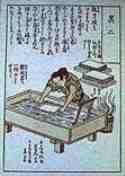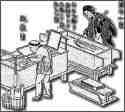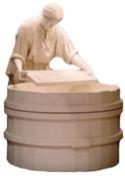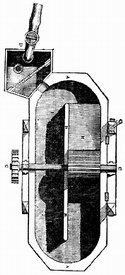Sales Campaign
Dokument nenalezen.
Paper History
Mankind has tried to improve methods of communication and recording information since ancient times. First attempts included using wax tables, leaves, bronze, silk and clay tables. With the invention of paper came the possibility of recording lots of information and transimitting it further at a low cost.
3000 years BC
 Of all the materials which people used for writing and drawing in the past, paper is the most widespread in the world. The word paper derives from the term papyrus, which was used by ancient Egyptians, Greeks and Romans. Papyrus, one of paper's predecessors, was made by means of pressure or threshing. These techniques are known as “TAPA”. Papyrus was mostly made from the inner pith of the paper mulberry, the fig-tree and the date-tree. The technology was known to almost all cultures found around the equator. The oldest technique for paper making – still used in some parts of the Himalayas and South-east Asia – leaves no doubt as to the origin of the TAPA technique. Cooked bast fibres were beaten by means of a wooden hammer to obtain a layer of thin fibres which was then suspended in a barrel with water to produce the pulp. A cast made of a wooden frame and a cloth base, was placed into a large container with water. The cloth part had to float beneath the water surface. Then a paper maker poured pulp needed for a sheet of paper into this “floating” cast and spread it with his hands all over the surface. The cast was then carefully taken out of the water. When the water drained away, the cast was placed in the sun or near a fire to dry. The paper sheet was formed on a wire sieve. After drying, the sheet easily separated from the cast and except for possibly smoothing there was no need for any kind of further processing. This technique had two disadvantages. Firstly, for each new sheet a separate cast was needed, which could be re-used only once the previous sheet had completely dried out. Next, the increase in production soon encountered a lack of raw materials, because fresh bast was not available everywhere in the required amount. Current discoveries of the oldest paper found in Chinese graves show that paper was made in China already in BC. Fibres normally used for making textiles, e.g. flax and hemp, were also used as bast. Later on the drying sieve was made of bamboo, which freed up paper makers from looking after the natural drying process on the sieve.
Of all the materials which people used for writing and drawing in the past, paper is the most widespread in the world. The word paper derives from the term papyrus, which was used by ancient Egyptians, Greeks and Romans. Papyrus, one of paper's predecessors, was made by means of pressure or threshing. These techniques are known as “TAPA”. Papyrus was mostly made from the inner pith of the paper mulberry, the fig-tree and the date-tree. The technology was known to almost all cultures found around the equator. The oldest technique for paper making – still used in some parts of the Himalayas and South-east Asia – leaves no doubt as to the origin of the TAPA technique. Cooked bast fibres were beaten by means of a wooden hammer to obtain a layer of thin fibres which was then suspended in a barrel with water to produce the pulp. A cast made of a wooden frame and a cloth base, was placed into a large container with water. The cloth part had to float beneath the water surface. Then a paper maker poured pulp needed for a sheet of paper into this “floating” cast and spread it with his hands all over the surface. The cast was then carefully taken out of the water. When the water drained away, the cast was placed in the sun or near a fire to dry. The paper sheet was formed on a wire sieve. After drying, the sheet easily separated from the cast and except for possibly smoothing there was no need for any kind of further processing. This technique had two disadvantages. Firstly, for each new sheet a separate cast was needed, which could be re-used only once the previous sheet had completely dried out. Next, the increase in production soon encountered a lack of raw materials, because fresh bast was not available everywhere in the required amount. Current discoveries of the oldest paper found in Chinese graves show that paper was made in China already in BC. Fibres normally used for making textiles, e.g. flax and hemp, were also used as bast. Later on the drying sieve was made of bamboo, which freed up paper makers from looking after the natural drying process on the sieve.
The year 105
 In 105 AD judge Ts'ai Lun invented paper making from textile waste, e.g. rags. It is said that Ts'ai Lun mixed the bark of the paper mulberry, hemp from fishing nets and rags with water, shredded them, formed a thin sheet, drained the water and left it to dry, and paper was born. That was the beginning of paper production as we know it today. Chinese producers gradually developed various types of paper (different sizes, coated and dyed paper, paper treated to protect it from damage and insects). The biggest problem was satisfying an increasing demand for paper. Bamboo was used as the next source of fibres. It was retted by cooking in lye. It is said that the great expansion of art, literature and science in China was made possible by paper as a means of communication among people.
In 105 AD judge Ts'ai Lun invented paper making from textile waste, e.g. rags. It is said that Ts'ai Lun mixed the bark of the paper mulberry, hemp from fishing nets and rags with water, shredded them, formed a thin sheet, drained the water and left it to dry, and paper was born. That was the beginning of paper production as we know it today. Chinese producers gradually developed various types of paper (different sizes, coated and dyed paper, paper treated to protect it from damage and insects). The biggest problem was satisfying an increasing demand for paper. Bamboo was used as the next source of fibres. It was retted by cooking in lye. It is said that the great expansion of art, literature and science in China was made possible by paper as a means of communication among people.
The year 610
 During the first centuries AD the Chinese method of paper making spread to Korea and in 610 AD it was introduced in Japan. Paper making became a typical feature of Japanese culture. Here, large amounts of paper are still produced by hand as a means of maintaning old traditions, mostly made from fresh mulberry bast fibres. The long uncut fibres are simply prepared by stamping, which gives the paper a unique appearance and excellent quality. Knowledge of paper making quickly spread to the Middle Asia and Tibet, and later to India. Samarqand became the centre of paper production. During their eastward expansion Arabs learned how to make a new material for writing.Subsequently paper factories were established in Baghdad, Damascus, Alexandria and later in Morocco, Spain and Sicily. Due to a shortage fo fresh bast, rags were used almost exclusively. The Arabs produced thin sheets, which were coated on both sides with starch. This gave Arabic paper good writing qualities as well as fine texture. The export of Arabic paper to Europe, especially to Italy, is well documented. Together with paper the secrets of its production were also sold. Italian paper makers tried to improve the Arabic technique from the 13th century in two early centres in Fabriano and Amalfi. Their efforts were not aimed at the raw material (cloth) but they substantially innovated the preparation and production process (use of water, wire meshes, paper press, drying).
During the first centuries AD the Chinese method of paper making spread to Korea and in 610 AD it was introduced in Japan. Paper making became a typical feature of Japanese culture. Here, large amounts of paper are still produced by hand as a means of maintaning old traditions, mostly made from fresh mulberry bast fibres. The long uncut fibres are simply prepared by stamping, which gives the paper a unique appearance and excellent quality. Knowledge of paper making quickly spread to the Middle Asia and Tibet, and later to India. Samarqand became the centre of paper production. During their eastward expansion Arabs learned how to make a new material for writing.Subsequently paper factories were established in Baghdad, Damascus, Alexandria and later in Morocco, Spain and Sicily. Due to a shortage fo fresh bast, rags were used almost exclusively. The Arabs produced thin sheets, which were coated on both sides with starch. This gave Arabic paper good writing qualities as well as fine texture. The export of Arabic paper to Europe, especially to Italy, is well documented. Together with paper the secrets of its production were also sold. Italian paper makers tried to improve the Arabic technique from the 13th century in two early centres in Fabriano and Amalfi. Their efforts were not aimed at the raw material (cloth) but they substantially innovated the preparation and production process (use of water, wire meshes, paper press, drying).
The year 1390
 During the rapid expansion of trade during the later Middle-ages, more and more wholesalers traded goods known as “paper” which was the result of its importance for public as well as for intellectual life. Hence it's no surprise that a member of Nuremberg Town Council Ulmann Stromer thought about making his own paper and with help of qualified Italian workers, he transformed the “GLEISMUHLE”, previously the gate to his home-town, into a paper factory. The dates recorded in his notes, 24th June, 7th and 11th August 1390 (the beginning of work on the water wheel) were the first paper making records in Germany.
During the rapid expansion of trade during the later Middle-ages, more and more wholesalers traded goods known as “paper” which was the result of its importance for public as well as for intellectual life. Hence it's no surprise that a member of Nuremberg Town Council Ulmann Stromer thought about making his own paper and with help of qualified Italian workers, he transformed the “GLEISMUHLE”, previously the gate to his home-town, into a paper factory. The dates recorded in his notes, 24th June, 7th and 11th August 1390 (the beginning of work on the water wheel) were the first paper making records in Germany.
The year 1453
 Johann Gutenberg invented the technology behind the printing press and made the first printing machine. This invention was a crucial step in paper making. Books became available in large numbers and this increased the demand for paper.
Johann Gutenberg invented the technology behind the printing press and made the first printing machine. This invention was a crucial step in paper making. Books became available in large numbers and this increased the demand for paper.
The year 1493
 According available records, paper making was still considered a great unknown and a secret art, and many technical obstacles still had to be overcome. The machine, which was drawn in Hartman Schedel’s World Chronicle from 1493, was constructed with two water wheels, 18 hammers and 12 workers needed one or two vats.
According available records, paper making was still considered a great unknown and a secret art, and many technical obstacles still had to be overcome. The machine, which was drawn in Hartman Schedel’s World Chronicle from 1493, was constructed with two water wheels, 18 hammers and 12 workers needed one or two vats.
The 16th century
 Paper making, which was spreading across Europe during 15th and 16th century, brought several advantages. Despite the substantial costs in time and capital involved in the construction of a factory and the necessary machinery as well as subsequent maintenance, thanks to the division of labour, change in production processes, performance and quality were improved. As some sources demonstrate, this meant profit. However, as business records from the period show, many paper makers failed to suceed due to an increased risk arising from an imbalance between expenditure and income. Later, more and more tradesmen working with paper bought paper factories, because the main producers operated through leasing. This trend increased among book manufacturers, where unusual coditions prevailed. Printers and publishers had to increase their production costs (paper, composition, print), but they were unable to use their income to cover expenses unless some of their output was already sold during production. This meant that they were often in debt to paper suppliers. Production required 4-member teams that would produce about 4,500 sheets of paper during a 13 hour shift, depending on format.
Paper making, which was spreading across Europe during 15th and 16th century, brought several advantages. Despite the substantial costs in time and capital involved in the construction of a factory and the necessary machinery as well as subsequent maintenance, thanks to the division of labour, change in production processes, performance and quality were improved. As some sources demonstrate, this meant profit. However, as business records from the period show, many paper makers failed to suceed due to an increased risk arising from an imbalance between expenditure and income. Later, more and more tradesmen working with paper bought paper factories, because the main producers operated through leasing. This trend increased among book manufacturers, where unusual coditions prevailed. Printers and publishers had to increase their production costs (paper, composition, print), but they were unable to use their income to cover expenses unless some of their output was already sold during production. This meant that they were often in debt to paper suppliers. Production required 4-member teams that would produce about 4,500 sheets of paper during a 13 hour shift, depending on format.
The 17th and 18th centuries
 Technological progress continued. Manual smoothing of sheets by means of special knives was replaced with a smoothing hammer, similar to a blacksmith's hammer. This divided the guild into traditional “smoothers” and modern “pressmen” , who refused to recognise each other as fully qualified. At the end of the 17th century another invention divided paper makers into two new groups. This was the beginning of a much more effective grinding process called a “Hollander beater”, which suplemented or even replaced stamping mills. A huge demand for paper production during the 16th and 17th centuries (reformation, book press) led to a serious shortage of raw materials and the setting of rules for trade in textile materials used in paper production. The continuing search for replacement materials later met with limited but immediate success, in the form of straw. But this raw material, as a basis for the first efficient paper machine in 1825, failed because of poor quality. Saxon Keller (1843) solved this problem discovering cellulose pulp, obtained from wood, and chemical cellulose (first patent in 1854, Melier Watt). During the 18th century the concentration of craft activities into factories began, but they nevertheless still depended on craftsmen organized in free guilds. Efforts to increase production as well as to restrict craft guild rules, led to increasing use of machinery. This led to the construction of the paper machine. The original model came for example from J.N.L.Robert who in 1798 constructed the first flat-screen paper making machine. The machine was handle operated, where the paper was made on a continuosly rolling belt. This machine was later improved (Donking and brothers Fourdrinier). Soon, other types appeared, for example a machine which filled wire casts which were moved on an endless chain and were placed on an endless felt base, and a machine with cylinders. Machines with flat screens and cylinder machines made an impact during the 19th century and were suplemented with a drying section. Many details were greatly improved. This led to an increase in the width of the screen and to higher production speeds. This also heralded industrialization. In this new situation, a small producer who was unable or unwilling to use machinery, believing he could survive by producing individual pieces or special types, was sooner or later forced out of the business. The rest had to adapt their existing premises or build new factories somewhere else.
Technological progress continued. Manual smoothing of sheets by means of special knives was replaced with a smoothing hammer, similar to a blacksmith's hammer. This divided the guild into traditional “smoothers” and modern “pressmen” , who refused to recognise each other as fully qualified. At the end of the 17th century another invention divided paper makers into two new groups. This was the beginning of a much more effective grinding process called a “Hollander beater”, which suplemented or even replaced stamping mills. A huge demand for paper production during the 16th and 17th centuries (reformation, book press) led to a serious shortage of raw materials and the setting of rules for trade in textile materials used in paper production. The continuing search for replacement materials later met with limited but immediate success, in the form of straw. But this raw material, as a basis for the first efficient paper machine in 1825, failed because of poor quality. Saxon Keller (1843) solved this problem discovering cellulose pulp, obtained from wood, and chemical cellulose (first patent in 1854, Melier Watt). During the 18th century the concentration of craft activities into factories began, but they nevertheless still depended on craftsmen organized in free guilds. Efforts to increase production as well as to restrict craft guild rules, led to increasing use of machinery. This led to the construction of the paper machine. The original model came for example from J.N.L.Robert who in 1798 constructed the first flat-screen paper making machine. The machine was handle operated, where the paper was made on a continuosly rolling belt. This machine was later improved (Donking and brothers Fourdrinier). Soon, other types appeared, for example a machine which filled wire casts which were moved on an endless chain and were placed on an endless felt base, and a machine with cylinders. Machines with flat screens and cylinder machines made an impact during the 19th century and were suplemented with a drying section. Many details were greatly improved. This led to an increase in the width of the screen and to higher production speeds. This also heralded industrialization. In this new situation, a small producer who was unable or unwilling to use machinery, believing he could survive by producing individual pieces or special types, was sooner or later forced out of the business. The rest had to adapt their existing premises or build new factories somewhere else.
